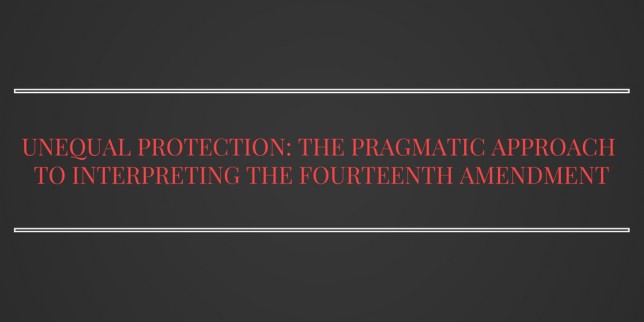By Adam J. Ondo, Comment Editor.
I. INTRODUCTION: A MOST RANDOM EXCEPTION
The thesis of this article is not that affirmative action in higher education is an immoral or unwise policy, but that it is unconstitutional under the Fourteenth Amendment if any formal theory of constitutional interpretation is applied. Worded differently, it is a criticism of the Supreme Court’s recent interpretations of the Equal Protection Clause as applied to the use of race in college admissions.
Affirmative action policies were around as early as the 1930s, when FDR’s Public Works Administration set up a quota system for minority laborers.[1] The first major case dealing with affirmative action in education was Bakke, a 1978 decision addressing a racial quota at the medical school of the University of California at Davis.[2] The petitioner challenged the quota under the Equal Protection Clause of the Fourteenth Amendment and prevailed. However, this was just the beginning of a long fight over whether race could be considered at all in college admissions.
In the early 2000s, the University of Michigan Law School’s admissions policy, which included racial and ethnic diversity as a “plus” factor, came under legal scrutiny from applicants who alleged that the policy violated the Equal Protection Clause.[3] The law school justified its admissions policy not by claiming that it was intended to correct past discrimination of minority groups, but that the law school sought a “critical mass” of minority students because diversity enriches everyone’s education.[4] The majority of the Court agreed that race could be considered as a “plus” factor because diversity in legal education was a compelling interest. A slight increase in educational benefits sounds more like a pretext than a compelling interest, but even if it is a compelling interest, there is another problem with using race as a plus factor. The problem with using race as a plus factor is that, as the Dean of the Law School, Jeffrey Lehman, testified, in some cases an applicant’s race is a “‘determinative’ factor.”[5] Race should never be a determinative factor if the Equal Protection Clause is to mean what it says.
In June 2016, the Supreme Court upheld the University of Texas’s use of race in admissions decisions, following the same reasoning found in Grutter.[6] The problem with carving out an exception to the Equal Protection Clause, for something as minor as slight educational improvements at the college level, is that it is inconsistent with any formal methods of interpretation. It is also dishonest to claim that educational benefits are compelling, while nothing else is compelling.
II. ORIGINAL MEANING
The Court in Bakke explained that “equal protection cannot mean one thing when applied to one individual and something else when applied to a person of another color.”[7] Therefore, even if the original meaning of the Equal Protection Clause is difficult to discern, it should be easy to determine what it does not mean: affirmative action. But, assuming that “benefits in higher education” is not just code for affirmative action, would the use of race in college admissions still be prohibited by the Equal Protection Clause?
One of the most basic canons of construction is that courts are not to presume exceptions where none are present.[8] If the drafters of the Fourteenth Amendment wanted race to be considered in certain situations, they could have included a provision in the Fourteenth Amendment stating such. This is not a ludicrous suggestion, as Canada’s Charter includes something very similar. Section 15(1) of the Charter provides, “Every individual is equal before and under the law and has the right to the equal protection of the law . . . without discrimination based on race . . . .”[9] Then Section 15(2) adds an exception: Section 15(1) does not prohibit the use of race in laws or policies intended to ameliorate the conditions of disadvantaged groups.[10] Unlike Canada’s Charter, the Fourteenth Amendment reads: “No state shall . . . deny to any person . . . the equal protection of the laws.” This prohibition is absolute; there are no qualifications or exceptions like those found in Canada’s Charter.
Therefore, the drafters of the Fourteenth Amendment should have included an affirmative action exception, or educational benefits, if that is what they had intended. But that is not what was intended. The Fourteenth Amendment was meant to prevent the South from circumventing the Thirteenth Amendment by enacting laws known as the Black Codes, which kept Blacks working on plantations as second-class citizens.[11] It did not have as its objective affirmative action or improving the state of higher education in America. But this is straying far from canons of construction and into legislative intent.
III. LEGISLATIVE INTENT
Some legal formalists believe that courts should not look at legislative intent, because (1) it is not real, as Congress is not a monolithic entity, and (2) we should not be bound by what legislators meant to say, but by what they actually enacted into law. But because some formal theorists rely on original intent, it is worth examining.
A. Original Intent
Until the past few decades, the Supreme Court had always viewed the Fourteenth Amendment as having “one pervading purpose,” namely “the freedom of the slave race . . . and the protection of the newly-made freeman and citizen from the oppressions of those who had formerly exercised dominion over him.”[12] Indeed, not long after its ratification the Court explained that the Fourteenth Amendment “was a development of the thirteenth, and is a more comprehensive exposition of the principles which lie at the foundation of the thirteenth.”[13] The original legislative intent, therefore, was not to remedy past wrongs but to prevent the unequal treatment of persons based on their race.
Even in the 1950s, the purpose remained one of promoting equal treatment for minorities, not preferential treatment for minorities. This is evident in the Sweatt v. Painter and Brown v. Board of Education decisions.[14] The outcome in Sweatt v. Painter is one of the best illustrations of how the Fourteenth Amendment should be applied based on its textual meaning. In Sweatt, the Court held that the University of Texas Law School and Thurgood Marshall School of Law, originally named Texas State University for Negroes Law School, did not have substantially equal facilities, meaning the State of Texas had to allow African Americans to attend the University of Texas School of Law.[15]
Looking at historical context, it should be obvious that the Fourteenth Amendment was intended to prevent unequal treatment, not remedy past wrongs. Because the drafters of the amendment would likely have balked at something as progressive as the Sweatt decision, an assertion that they would support affirmative action in education—a policy unknown in the nineteenth century—would be most dubious.[16]
B. Current Intent
Unlike original intent textualists, legal pragmatists try to take a broad intent and combine it with modern policy views to create an outcome more to their liking. The pragmatists on the Court, also called activist judges, may try to justify the use of race in certain educational circumstances by pointing to the broad intent of the Equal Protection Clause, which was to make minorities equal, and combine it with the Civil Rights Act, busing policies, and Brown v. Board of Education. A criticism of this approach can be found in the Bakke decision, “[T]he mutability of a constitutional principle, based upon shifting political and social judgments, undermines the chances for consistent application of the Constitution from one generation to the next, a critical feature of its coherent interpretation.”[17]
IV. CONCLUSION: A MERCURIAL JURISPRUDENCE
The issue with many Supreme Court Justices is that they do not operate under a set framework so their reasoning appears either whimsical or as a mere justification for imposing their personal views on the public. The flaws in the pragmatic approach taken by many of these Justices shine through in cases such as Grutter and, more recently, Fisher. First, the text of the Fourteenth Amendment suggests that basing a decision on race is abhorrent, and because, unlike Canada’s Charter, the Fourteenth Amendment lacks express exceptions, courts are not to imply any exceptions. Second, it is preposterous to claim that the sole recognized compelling interest excepted from the binds of the Fourteenth Amendment is diversity in education. Surely diversity in employment is just as compelling. If this issue returns to the Supreme Court, instead of carving out random exceptions to an amendment that is devoid of any exceptions or qualifications, the Court should apply a more formalistic approach to avoid usurping the power of Congress.
[1] 1 Jyotsna Sreenivasan, Poverty and the Government in America: A Historical Encyclopedia, 449 (2009).
[2] Regents of the Univ. of Cal. v. Bakke, 438 U.S. 265, 269–70 (1978).
[3] Grutter v. Bollinger, 539 U.S. 306, 311 (2003).
[4] Id. at 315–16.
[5] Id. at 319.
[6] Fisher v. Univ. of Tex., 579 U. S. ____, 136 S. Ct. 2198, 2210 (2016).
[7] Bakke, 438 U.S. at 289–90.
[8] French’s Lessee v. Spencer, 62 U.S. 228, 238 (1858) (noting “that where the Legislature makes a plain provision, without making any exception, the courts can make none.”).
[9] Canadian Charter of Rights and Freedoms, Part I of the Constitution Act, 1982, being Schedule B to the Canada Act, 1982, c 11 (U.K.), § 15(1).
[10] Id. § 15(2).
[11] N.L.R.B. v. Houston Distrib. Servs., Inc., 573 F.2d 260, 266 n.5 (5th Cir. 1978) (explaining that “distinguished historians from various viewpoints all agree that one of the primary reasons for the fourteenth amendment was the existence of ‘Black Codes’”).
[12] Bakke, 438 U.S. at 291 (citing Slaughter-House Cases, 83 U.S. 36, 72 (1872)).
[13] Slaughter-House Cases, 83 U.S. at 51.
[14] Sweatt v. Painter, 339 U.S. 629, 635 (1950); Brown v. Bd. of Educ., 347 U.S. 483, 495 (1954).
[15] Sweatt, 339 U.S. at 633.
[16] See generally Bakke, 438 U.S. at 265 (striking down a racial quota applied to the admissions process at a public university).
[17] Bakke, 438 U.S. at 299.

